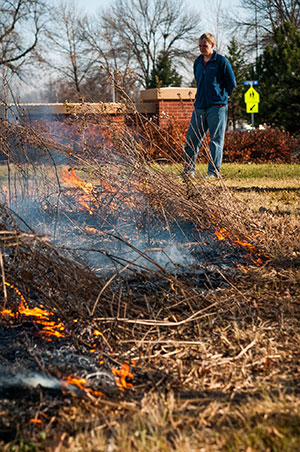John Sehloff and Chad Heins from Bethany’s biology department, together with several students, staged a controlled burn of a small prairie garden on the Bethany campus on this beautiful 8th of November.
Sehloff noted that with the drought in southern Minnesota, he was concerned about burning, but with some recent rains the Mankato Fire Department issued the College a burn permit.
Burning gives the advantage of clearing the old growth and allowing new seedlings to spring up. It also releases the minerals and nutrients from the dead plant matter back to the soil much more quickly than just waiting for it to decay and work its way back into the soil. Another benefit to a prairie burn is to help control invasive species that often outcompete the native plants.
Sehloff noted, “We have two main ones we want to control—Bird’s Foot Trefoil and Reed Canary Grass that will hopefully be less of a problem after the burn.”
In some years the plantings have simply been mowed, while in other years it was left standing.
“The prairie burn went well. This is the second time we have burned the area since 2002 when it was planted. I think the last time was 3 years ago. When we have a good snowy winter it gets mostly knocked down. Last winter, with the lack of snow, we ended up with a lot of dead growth and it looked a bit ragged this past summer,” noted Sehloff.
Prior to the burn, the class collected seeds from the prairie plants and will sow those back into the garden during a botany class on Friday, November 9. The seeds were harvested somewhat selectively and will hopefully provide those species with a head start in the spring of 2013.
Most of southern Minnesota was native long grass prairie as it was settled and few spots remain that were not farmed or grazed at some point. Bethany’s small patch gives students a chance to see some of the native plants and serve as an ideal location for general biology students to collect insects.
More photos of the burn and a short video can be seen on Bethany’s Flickr page.


